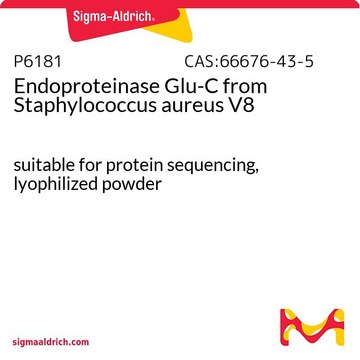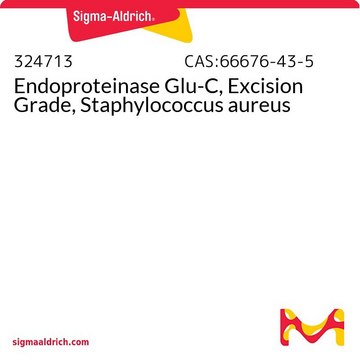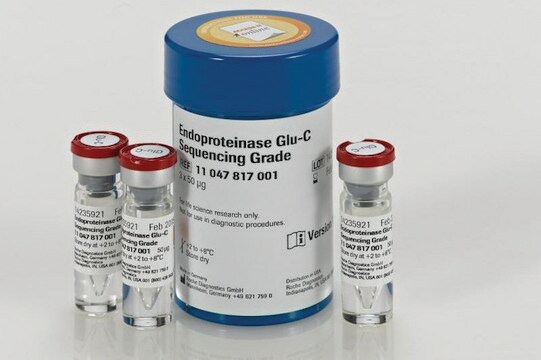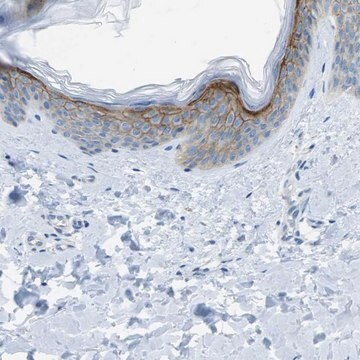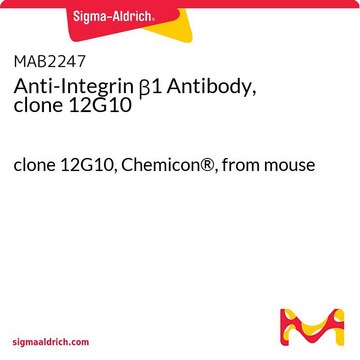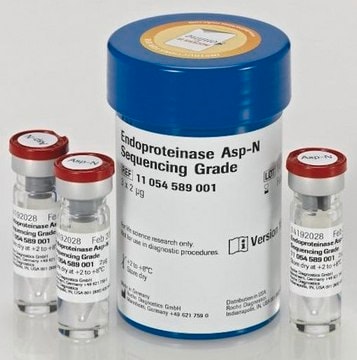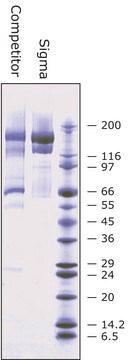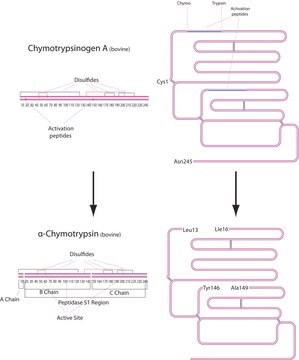10791156001
Roche
Endoproteinase Glu-C (V8 Protease)
from Staphylococcus aureus V8
Synonym(s):
V8 protease, protease v8
Sign Into View Organizational & Contract Pricing
All Photos(1)
About This Item
Recommended Products
form
lyophilized (salt-free)
specific activity
20 U/mg
mol wt
30 kDa
packaging
pkg of 2 mg
manufacturer/tradename
Roche
optimum pH
8.0-8.5
Related Categories
General description
Approximately 20 U/mg lyophilizate at +25°C with Z-Phe-Leu-Glu-4-nitranilide as the substrate (approximately 500 U/mg lyophilizate at +37°C with casein as the substrate).
At 25 °C with Z-Phe-Leu-Glu-4-nitranilide as the substrate (approximately 500 U/mg lyophilizate at 37 °C with casein as the substrate).
Endoproteinase Glu-C is a Staphylococcal serine proteinase. Its inhibitors are DFP, α2-macroglobulin and TLCK.
Specificity
Heat inactivation: Endoproteinase Glu-C is inactivated by boiling for ten minutes.
Application
Use Endoproteinase Glu-C (V8 Protease) for protein structure analysis and for sequence analysis.
Biochem/physiol Actions
Endoproteinase Glu-C specifically hydrolyzes peptide and ester bonds at the carboxylic side of Glu, or both Glu and Asp, depending on the buffer used.
Preparation Note
Activator: The enzyme has its maximal activity in presence of SH-reagents
Working concentration: 1 to 5 mM
Working solution: Recommended solvent is 50 mM ammonium acetate pH 4.0 (2 mg/ml).
Storage conditions (working solution): -15 to -25 °C
The enzyme (2 mg/ml in 50 mM ammonium acetate, pH 4.0) is stable for at least one month, frozen in aliquots and thawed only once.
Working concentration: 1 to 5 mM
Working solution: Recommended solvent is 50 mM ammonium acetate pH 4.0 (2 mg/ml).
Storage conditions (working solution): -15 to -25 °C
The enzyme (2 mg/ml in 50 mM ammonium acetate, pH 4.0) is stable for at least one month, frozen in aliquots and thawed only once.
Storage and Stability
Store at 2 to 8 °C. (Store dry!)
Other Notes
For life science research only. Not for use in diagnostic procedures.
Signal Word
Danger
Hazard Statements
Precautionary Statements
Hazard Classifications
Eye Irrit. 2 - Resp. Sens. 1 - Skin Irrit. 2 - STOT SE 3
Target Organs
Respiratory system
Storage Class Code
11 - Combustible Solids
WGK
WGK 1
Flash Point(F)
does not flash
Flash Point(C)
does not flash
Choose from one of the most recent versions:
Already Own This Product?
Find documentation for the products that you have recently purchased in the Document Library.
Customers Also Viewed
Rosalynn C Molden et al.
Current protocols in protein science, 77, 23-23 (2014-08-02)
Histones are chromatin proteins that are highly modified with many different types of post-translational modifications. These modifications act in concert to regulate a number of chromatin-related processes. However, identification and quantification of co-occurring histone post-translational modifications is challenging because there
Marion Avril et al.
PLoS pathogens, 9(6), e1003430-e1003430 (2013-07-05)
During blood stage infection, Plasmodium falciparum infected erythrocytes (IE) bind to host blood vessels. This virulence determinant enables parasites to evade spleen-dependent killing mechanisms, but paradoxically in some cases may reduce parasite fitness by killing the host. Adhesion of infected
Tianshi Wang et al.
Molecular cell, 75(4), 823-834 (2019-07-16)
Sirt3, as a major mitochondrial nicotinamide adenine dinucleotide (NAD)-dependent deacetylase, is required for mitochondrial metabolic adaption to various stresses. However, how to regulate Sirt3 activity responding to metabolic stress remains largely unknown. Here, we report Sirt3 as a SUMOylated protein in
Our team of scientists has experience in all areas of research including Life Science, Material Science, Chemical Synthesis, Chromatography, Analytical and many others.
Contact Technical Service